Nothing ruins a good workout like bad spotting. Bad spotting can disrupt your set, rob you of the intensity necessary to trigger gains, and even lead to injury. Conversely, good spotting can help turn a good workout into a great one.
Most lifters will be called upon to spot at some point. For example, it could be your regular training partner or a complete stranger who utters the words, “hey, spot me, bro!”
Perfect your spotting skills by following the guidelines in this article.
What is Spotting, Anyway?
According to an old American College of Sports Medicine (ACSM) that I have left over from my studies, spotting can be defined as:
“The use of a person, such as a coach or personal trainer, to assist in the execution of an exercise to help protect the athlete from injury.”
For example, imagine you are doing bench presses, and you decide to slap on a few extra plates and really push yourself.
Because you know there is a risk of getting pinned under a heavy bar, you ask someone to watch over you while you lift. That way, if you cannot complete a rep, they can help you finish your set and then rerack the bar.
A well-timed spot can save you from serious injury. Any exercise where there is a risk of getting crushed by a heavy weight will benefit from spotting.
Exercises that often need spotting include:
- All types of bench press (barbell, dumbbell, incline, flat, decline)
- All types of overhead press
- Skull crushers
- French press
- Squats
- Some machine exercises, e.g., lat pulldown, triceps pushdown, and leg curls
However, while spotting can save you from accident and injury, there are several other reasons you may want or be asked to spot. These are:
Forced reps
Even when you train to failure, you haven’t exhausted all your muscle fibers. Instead, you are simply unable to produce enough force to lift the weight you are using. Forced reps is a method where your partner provides assistance through spotting so that you can continue training beyond failure.
You can do one forced rep or several. Either way, forced reps can significantly raise the intensity level of your workout.
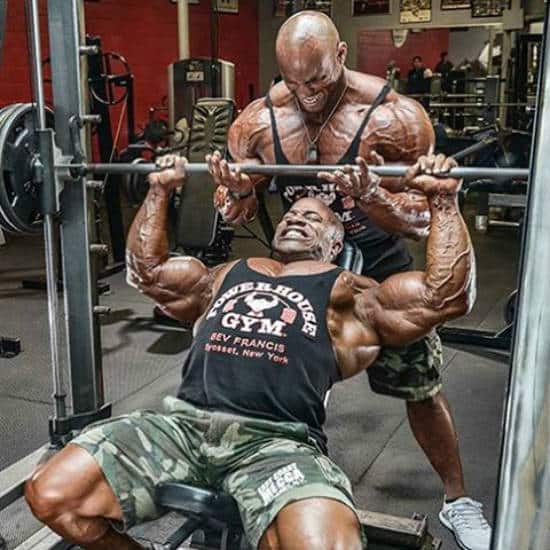
Negative training
With negative training method, the spotter actually does most of the lifting, and the person exercising lowers the weight unaided, focusing almost entirely on the eccentric or negative portion of each rep. This is an intense training method best left to experienced exercisers.
Overcoming sticking points
Many exercises have sticking points. These occur at angles where the lever is longest, and the weight is furthest from the fulcrum or moving joint.
A well-timed spot can help you overcome this sticking point so that you can a) use more weight and/or b) do more reps without resorting to cheating. For example, a little help when your elbows are at 90 degrees during barbell biceps curls.
Increased confidence
Whether you are lifting more weight than usual or trying to do more reps, having a spotter on hand could be just what’s needed to boost your confidence and push yourself beyond your previous limits.
Even if your spotter doesn’t give you any practical help, just knowing that you have someone watching over you could be enough for you to attempt that “maybe” rep that you wouldn’t have tried alone.
Encouragement
A lot of lifters train harder with a spotter than without one. There is a certain amount of psychological pressure when lifting in front of an audience that could boost your performance.
And, if you tell your spotter you’re going to do ten reps, you probably will. Plus, the person providing the spot can help verbally encourage you.
Guidance and correction
A good spotter can help fix your lousy lifting technique. In some exercises, they can even guide your limbs to ensure you’re doing your chosen exercise correctly, e.g., during dumbbell flies or lateral raises. A spotter can also control your tempo and ensure that you are using the full, correct range of motion.
Safer unracking and reracking
While accidents can happen at any point in a set, the unrack/rerack part is arguably the riskiest. Both involve maneuvering a heavy weight off and back onto J-hooks, and all it takes is a small mistake for the bar to come crashing down. A spotter makes unracking and reracking a loaded barbell much safer.
When Spotting Goes Bad
While a good spot can add a lot to your workout, bad spotting can ruin it. Spotting sins include:
Standing in the wrong position
There is a right place and a wrong place to stand for spotting. The right place is safe and effective (for both parties), while the wrong place puts one or both of you at risk. Make sure that the spotter isn’t in the way, but they’re also in a position where they can lift safely, i.e., without rounding their lower back.
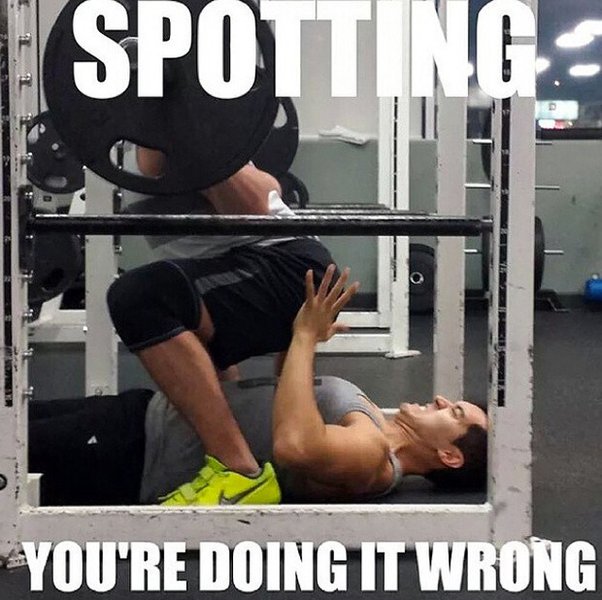
Taking too much weight
Unless you are doing negative training, spotters should provide the minimum of assistance necessary to complete the desired number of reps. After all, the whole point of strength training is to push yourself! If the spotter takes too much weight, it could make the workout less effective.
So, if you feel you are doing more work than the person you are spotting, it could be that they’ve overestimated their strength, and they need to strip some weight from the bar. The spotter isn’t the one training!
Coming in too soon
Unless you’re spotting very heavy weights, you should only need to spot the last couple of reps of a set. Be close and ready, but don’t start helping too soon. You may not be needed at all!
Not being attentive
If you are going to spot, make sure you pay attention to how the set is progressing so you can be in the right place and ready to help at the right time. You are there to spot, so don’t let your mind wander or start looking around. Instead, focus on the person you are working with.
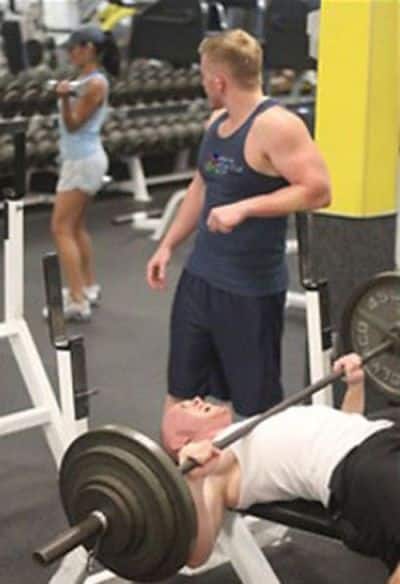
Poor communication when spotting
Both parties need to communicate effectively while spotting. After all, neither are mind-readers. The spotter needs to know when to step in, and the lifter needs to know when to expect the weight. Poor communication can lead to serious injuries.
Unwarranted spotting
Spotting is usually unnecessary for warm-up sets. Some exercises don’t even need spotting, such as bent-over rows, deadlifts, power cleans, and lunges. Asking for or trying to provide a spot for unspottable exercises will probably cause more problems than it fixes.
Unsolicited spotting
Not everyone wants or likes to be spotted. So, while there is probably no harm in offering to give someone a spot, it would be pretty rude to just dive in and start helping if you haven’t been asked.
Of course, if you think that someone is about to be crushed under a heavy weight, you shouldn’t just stand and watch. They may need help whether they want it or not. However, even then, unsolicited spotting could be seen as inappropriate, so only step in if you feel it’s 100-percent warranted.
How to Spot
Spotting techniques vary from exercise to exercise, and what works in one situation may not be right for another. Here are some guidelines to follow. Remember, though, that common sense should prevail, and you may need to adapt these methods depending on the exercise you are spotting.
Barbell exercises
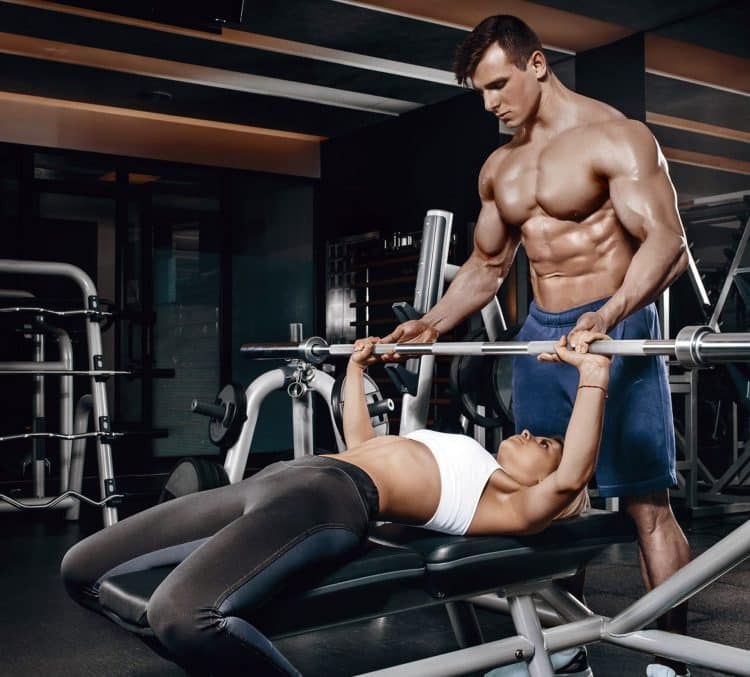
When spotting barbell exercises, it’s generally best to take hold of the barbell itself. This can be done with an overhand, underhand, or mixed grip as preferred. You may not even need to take a full grip on the bar, and a little assistance with your fingers may be all that’s required to aid in the completion of the reps.
That said, barbell exercises often involve heavy weights, so you should always be close enough that you can react quickly if you need to take more of the load.
The main exception to this guideline is for spotting squats. Invariably, squats involve heavy weights, and you won’t be able to apply much force if you hold the bar. Instead, it’s more effective to place your arms under the armpits of the person you are spotting or even wrap your arms around their chest.
This is quite an invasive maneuver, so you should only do it after getting the go-ahead from whomever you’re working with. You may also want to practice it with lighter weights as it can be a little difficult to master.
Dumbbell exercises
There are two ways to spot dumbbell exercises, and they both have fans and detractors, pros and drawbacks. Try them both and see which one you and the person you are spotting prefer.
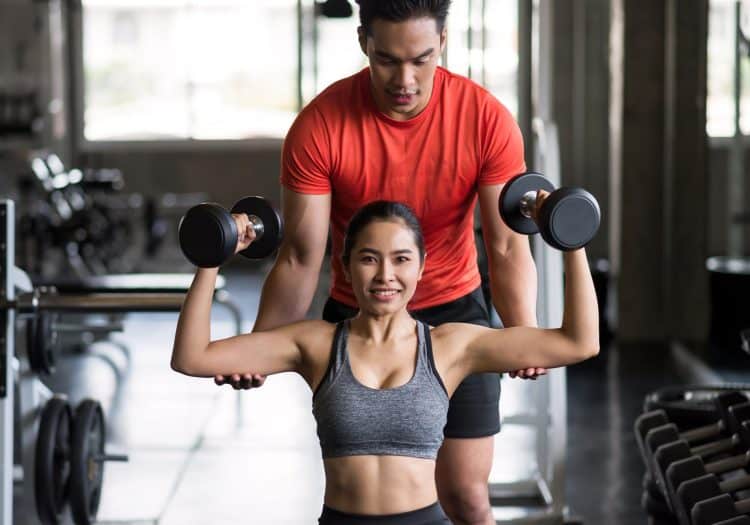
With option one, you grip the wrists of the person you are spotting. This gives you a lot of control over the weights but can be uncomfortable for the person you are spotting, especially if they need a lot of help.
Option two involves applying pressure under the elbows. This is good for providing assistance but not much use for stopping the weights from straying off their correct path. In theory, and despite your best efforts, the dumbbells could still fall inward or backward to cause injury.
Machine exercises
While you probably won’t need to spot machine exercises for safety purposes, it can still be helpful. For example, you could do forced reps of lat pulldowns or triceps pushdowns or make sure you are using the fullest possible range of motion on leg extensions or leg curls.

In most cases, the best way to spot a machine exercise is by applying pressure to the machine itself. There is no need to touch the person you are spotting. However, with some exercises, this may mean pulling or pushing on the machine’s handles or pulling on a cable.
However, you MUST make sure your fingers or hands won’t get pulled into the machine’s mechanism. Watch how the machine works, and then decide on the safest place to put your hands. For example, do not put your fingers between the weight stack, which is an accident waiting to happen.
How to Be A Good Spotter – Wrapping Up
Spotting is a crucial gym bro skill. It’s important for safety and can even make a workout more intense and productive.
Whether you’ve just been asked to spot a stranger or you are spotting your long-time training partner, you need to do your job right!
So, learn to be a good spotter and be ready to provide a spot when asked. Don’t be that guy who always asks for a spot but never returns the favor. And remember, at least some of your bro-rep hinges on your ability to be a good spotter.



Very helpful – but most gym bros are too busy on their phones to offer a spot. Not like the old days when we all helped each other out. Now they’re all too busy taking selfies or videos for their social media pages.